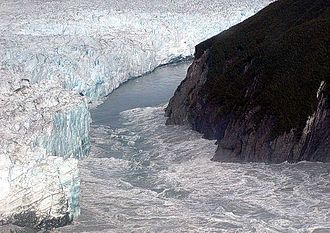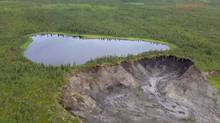July 23, 2015 – Sea ice volume is a different measure than sea ice extent. Volume looks at the thickness of the ice as well as the area of coverage. Extent is just about the latter. When the European Space Agency (ESA) launched CryoSat-2 in 2010, scientists for the first time were able to gauge volume and in the first two years of observation it was in decline. But in 2013 and 14 this trend reversed.
Why did sea ice volume in the Arctic grow?
In the journal, Nature Geoscience, published July 20, 2015, an article appears entitled, Increased Arctic sea ice volume after anomalously low melting in 2013. Based on five years of CryoSat-2 measurements it describes a 14% reduction in Arctic sea ice volume from 2010 to 2012, followed by a 33% increase in 2013 and 25% increase in 2014. Associated with the increased sea ice volume it was observed that there was a decline in the number of days on which melting occurred amounting to 5%, a departure from conditions more typical to the late 1990s. The evidence for increased volume comes from older ice around Greenland and the northern Canadian archipelago where the usual melting pattern disappeared during these two summers.
With only five years of data from CryoSat-2 so far, it is difficult to draw any conclusions.
Are we witnessing a previously unknown cycle of ice volume decline followed by increases? Or is this a temporary phenomenon reversing what is believed to have a continuous decline? The researchers obviously need to observe more than five years of data to develop a model that can explain what has been observed.
In the face of all the other climate science that points to warming of the Arctic at a faster pace than anywhere else on the planet, climate change skeptics are in full denial mode pointing to this new evidence.
But climate science doesn’t draw conclusions from one or two years of data. Climate science looks at decades, centuries and millennia before putting together a hypothesis and developing models that can explain the observations.
Greenland glacier behavior tells a different story.
In the latest released study published June 30, 2015 in the Geophysical Research Letters, a team of glaciologists from University of California Irvine describe evidence of faster melting of Greenland glaciers.
In a 2014 expedition to the Arctic researchers from UC Irvine found coastal glaciers in Greenland were increasingly being undermined by ocean water. Previously it was not known the depth of the face of these glaciers. But by taking measurements at the face of these Greenland glaciers the team found many severely eroded with cavities under the ice edge forming. The cause, contact with warmer, salty Atlantic Ocean water. The pattern of undercutting was seen as a likely source of increased calving from the glacier’s terminal face as well increased instability of the ice front, a ticking time bomb.
Why a ticking time bomb?
Unstable ice, whether an ice berg, or a glacier, will do unusual things. Ice bergs as they melt will suddenly roll and if you are in a boat nearby you can suddenly find yourself flung into the air by the rising ice from beneath the surface.
Unstable ice in the Antarctic has led to ice shelf instability. Quick collapses have occurred. In previous postings I have written about such collapses and upcoming imminent collapse for the Larson A and B ice shelves in the Antarctic Peninsula. When a shelf is attached to a land-based glacier and it destabilizes the entire glacier becomes unstable.
A number of Greenland glaciers are already exhibiting new behaviors speeding up their advance to the sea. What the UC Irvine team observed may be the reason for these changes. As more ice enters the Atlantic from the land it adds to ice sea volume temporarily. It also in introducing the ice which is freshwater, a source which forms a surface over the heavier, saltier ocean water. With a lower specific gravity and a higher freeze temperature than salt water, we can see the potential explanation for what CryoSat-2 has observed.
But there is a far more dangerous potential result from instability in a glacier, and that is a sudden, catastrophic change where the glacier simply disintegrates and begins rushing to the ocean leading to accelerated calving. Geologists have suspected for some time that variations in the climate record during the Pleistocene may be linked to just such catastrophic events. One in particular is worth nothing. It occurred in the area of North America’s Great Lakes 12,800 years ago. At the time Lake Agassiz dominated an area larger than the present lakes. It was held back from the Atlantic by an ice barrier that acted as a dam until one day it broke. A catastrophic event followed with the lake emptying into the North Atlantic Ocean. The freshwater overrode the ocean water, deflected the Gulf Stream, and put Europe into a mini-ice age that geologists call the Younger Dryas. It happened in a geological instant. In a single season Europe went from being a temperate world to become a deep freeze.
On a smaller scale in the last week, a lake in the Mackenzie River basin of the Northwest Territories, seen in the image below, is about to collapse as the last few meters of its icy permafrost melts and slumps sending the lake crashing down almost 200 meters (600 feet) to the river valley below. In the foreground you can see the progressive slumping of the permafrost from longer thaws in the summer time and increasing rainfall in the region. It is only a matter of days.










